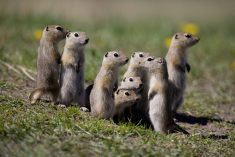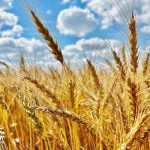Sandra Vos raises cattle in Brant County, Ont., in a way that works best for her and her land.
Her story is both inspiring and thought-provoking when it comes to expanding the concept of who can be a participant in the business.
Imagine taking on learning the ins and outs of raising cattle as a second career, with no real background in the industry. Whether she was fully aware of the challenges ahead, or simply prepared to meet them coming from her first career in health care, Vos has built a new image to appreciate among those who make up Canada’s beef producers.
Read Also

The Canadian Cattle Association’s international advocacy efforts
Global ag policies affect Canadian food policy, so the Canadian Cattle Association participates in international and domestic forums
“When I started, people expected me to pack it in,” says Vos, who is a one-woman operation. “My concept was whatever I decide for me, since this was my farm.”
While her husband Leo, a dentist, and their three grown children were supportive, the enterprise was her own.
In the two decades since jumping in, Vos has learned a whole lot about farming, becoming a spokesperson for sustainability, cattle, soil and agriculture’s role in the economy along the way. Plus, she can now drive a tractor!
The roots
When a relative desperately needed to sell his land in 2001, Vos, who had spent time as a kid helping her uncle on his farm, didn’t hesitate. She came home and announced to her family she’d just purchased an 80-acre parcel of land and was going to go learn to be a farmer.
“It was a leap of faith,” Vos says. But she took many of the skills gained through her graduate degree in nursing and nearly three decades of community health work and applied them to this new challenge.
“I came into farming with no preconceived ideas. It gave me a sense of freedom to experiment. I didn’t know the neighbours, but then again, I never did worry too much about what people thought.”
From the start, she saw the land as a gift and had a desire to take care of it. One of the first things she did was take a seminar on how to grow hay and market it.
“I knew hay was good for the land, but I also knew manure was good for the land. I wanted to do a direct meat market eventually and you need cows to do that. But it had to be something I could manage on my own.”
Vos also became fascinated with research studies on the importance of good soil. As a nurse, she could see the parallels between how the foundation affects health down the road.
“Start at the source, the soil, and make it the best you can,” she says.
“It was self-taught learning. I read a lot of books and articles and started attending industry conventions.”
The land
Vos’s farm is in Ontario’s prime agricultural area, about an hour from Toronto. It’s on the northern fringe of the Carolinian Forest, a diverse eco-region with some of the warmest average annual temperatures in the province. It’s cash-crop country, and her land had been in corn or bean production for many years. Vos seeded 30 acres to hay right away and now has converted it all to hay or pasture.
Part of Vos’s early research included a trip to New Zealand to learn about pasture management.
“That’s where I saw rotational grazing in practice. I really liked how you protect the forages and don’t try to wear out a piece of land. And it was something I could manage. You didn’t need big machinery.”
Vos did acquire some basic hay equipment, initially hiring out the cutting, until she took the plunge and bought a haybine.
“I buy things really slow,” she chuckles. “My philosophy is minimalist. Only the essentials. I don’t need a lot of extra iron.”
Small square bales were the first source of income, for the nearby horse market, as well as some rabbit-raising customers. But she does now make and use mainly round bales, with the help of a ‘new to her’ cabless tractor.

The responsibilities
Vos knew livestock would help build resiliency into her land. Based on what she’d seen in New Zealand of grass performers, she’s built a Red Angus herd, with a Black Angus bull, keeping them on pasture or bale grazing them all year long.
“I started the pasturing based on the amount of money I could afford to fence because there was no fencing on the property. As I fenced more of the property, I was able to bring in other parts of the land,” says Vos.
Vos dubs herself a “queen of fencing” who can tell you about every trend going. She’s tried it all, from page wire to electric, and even baler twine in a pinch. These days she’s settled on temporary poly for interior corridors of her permanent pasture, allowing her to change the configuration based on the weather and growing conditions. But with the farm near two busy roads, she invested in secure fencing for her perimeters.
Vos moves her “girls” daily, intensely grazing each piece. Everything gets used, even grass around the yard and machinery. She goes around the farm three times, and four on some of the non-hay land every season.
After fencing off the creek on her property (which is home to brook trout since it’s cold water) cattle watering has been a big job. Vos does have an above-ground system but admits to having cursed that more than anything else on the farm. She moves a 40-gallon tank, with quick connect couplers on her water line, to attach in each new spot.
The trick has been finding the best herd size for her system. It’s been as high as 35 cows, but a dry 2012 forced a cutback. Her count now is about 23 head, plus the stockers she saves for her direct meat market.
Vos is always monitoring her fields after grazing, to ensure their ongoing health. But she also sees the land’s role in a bigger picture, as she tries to blend the needs of the soil, the wildlife and the regulations she faces, with her own economic realities.
“This is my stewardship responsibility — not only to feed cattle but look after the food there for a whole bunch of critters that became an important part of it,” says Vos, who is a past recipient of the Ontario Environmental Stewardship Award.
The cows
As a nurse, Vos’s natural priority is healthy animals, and she keeps cows in the herd as long as viable, with many of them over 10 years old.
Good temperament is a must. “If I get hurt, who’s going to farm?”
Vos even manages to adapt calving to her lifestyle, since she doesn’t live on-site at the farm.
“The cows have to calve on their own. If they’re problem mothers, they go on the truck. The rare problem that can cost a calf is a trade-off I can live with. It saves me to-ing and fro-ing. I’ve had to call a vet twice in 20 years.”
Vos is certified through the VBP+ program, which she sees as important to move the industry forward.
“People understand quality assurance program standards, so I try to practice them and get on board. It’s our way of changing people’s perceptions. If these programs make a dent, let’s get behind them.”
Vos markets her beef directly to customers in the region, through word of mouth, as well as selling through Carve Premium Beef (carvebeef.ca).
Grass-fed is the market niche that makes economic sense for her.
“I was too small to invest in anything but that. Sure, you can bring in grain and feed, but it just didn’t seem to work for my bottom line and I wasn’t interested in it. I’m very lazy,” she says.
“I look at what does my consumer want, and then I work backwards. Again, that’s the nurse in me — you’re constantly evaluating and reassessing.”
The surroundings
It wasn’t always easy being the newcomer and a woman operator in a long-established agricultural area. But that didn’t intimidate Vos.
“The quickest way to get accepted was to get involved. I sat on community boards. If you want to build a sense of community development, go on boards,” she says.
“Also, I could learn from all those farmers who’ve been there long before me, about what to do and what not to do for my own operation.”
Vos is president of the Brant County Federation of Agriculture, and has been involved in the Brant Cattlemen’s group, Beef Farmers of Ontario and the Soil and Crop Improvement Association. She also puts her community health experience to use as a volunteer in other organizations.
With her small beef operation, Vos supports her local abattoir, and community, by hiring out what she can’t do herself. But the urban encroachment challenge is real, in a region where land is selling for $20,000 an acre.
“We probably have more eyes on us here in southern Ontario than what some people are used to,” says Vos, about the density around them, and the extra regulations they face.
Development and cash cropping are stiff economic competitors for a beef farm. She’s glad to have bought her parcel before the land bankers became active, driving even agricultural land prices up dramatically.
That’s why Vos believes it’s so important to tell agriculture’s story, like being the farm voice in her hometown Chamber of Commerce, and volunteering with the agriculture program for elementary students. She’s happy to be known as “the beef lady” of a district where a cattle-only farm is rare.
“Communication skills were also a big part from the nursing — explaining things in terms that people understand.”
The Vos way
Sandra Vos is grateful for her nurse’s perspective on the farm.
“I always looked at how to prevent a problem before it happened.”
She also sizes up what’s safe and efficient, what she can do herself and what she can afford.
While she admires the risk-takers of the cattle business, she’s well aware that’s just not her MO. For her, it’s quality over quantity.
“We can produce galore … but don’t always think of the end market. There are two ways to do things, produce more or save on expenses. Saving on expenses was easier for me. Is it a male vs. female approach? I’m a farmer first, and a woman second. But it does influence how my thinking affects my decisions,” she says.
“The nurse in me sees two sides to the story. We need to balance keeping the soil healthy with the economic bottom line for the farmer. Because in Canada, we are not recognized for environmental goods and services enough.”
Vos knows what she can’t do, and what she’s interested in learning. “I guess this is where my heart is — in the soil and grasslands and leaving things alone,” she says.
“I farm like a girl and it works for me!”
She’s also happy to have blazed her own beef trail, exceeding everyone’s expectations.
“Including my own,” laughs Vos.
















